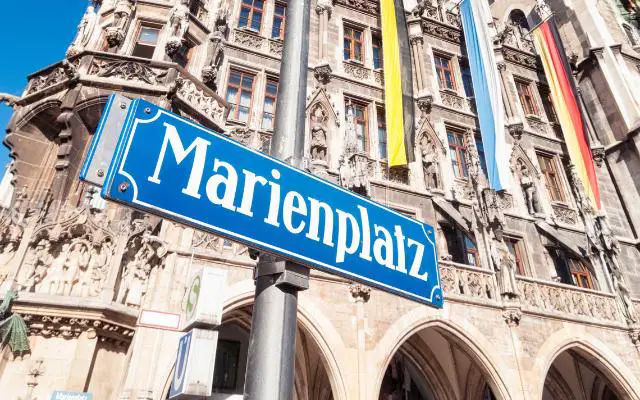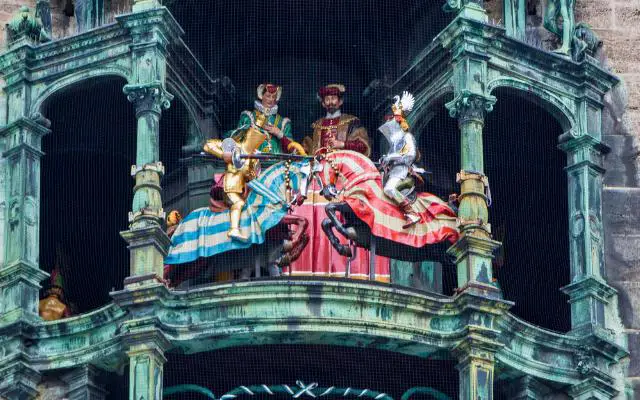The Glockenspiel Munich is a dazzling sight that comes alive daily with chimes and dancing figurines that enact stories from centuries past.
Crowds gather regularly in Marienplatz in the center of Munich, transfixed as the iconic clock tower brings Munich’s rich history to life through music and antique animatronic dance.
This mechanically automated wonder was built in the early 1900s and still enthralls visitors with its performances that take place multiple times per day.
As the figurines whirl into motion high up on the ornate clock, it feels like you’re being transported back in time, and even if you’ve seen the performance many times, just as we have, it still has that effect on a person.
In this article, we’ll uncover everything you need to know about the Glockenspiel clock as we explore together the magic and lore behind one of Bavaria’s most enduring and publically loved sights!
What is the Glockenspiel Clock in Munich?
You’ve probably seen a lot of cool and unique things during your lifetime and travels. However, we’re almost certain that you have never seen anything like the Glockenspiel in Munich.
The Glockenspiel is an ornate clock tower located in Marienplatz Square in central Munich. It brings the city’s history to life through chimes, music, and moving figurines.
The 45-meter tall tower contains 43 bells and 32 life-sized figures that whirl into motion during performances enacted twice daily. The gothic-style tower provides a majestic frame for the clock.
The figures are clad in period costumes and depict famous events and characters from Munich’s history. The inner workings run precisely on clockwork, weights and gears with no electricity.
While the figurines are wood, the bells are cast bronze, with the largest over 1000 kg! Yet the chimes remain musical.
The soaring Glockenspiel Tower is an iconic symbol of Munich. Visiting Marienplatz to witness a performance is a quintessential Munich experience.

The History of the Munich Glockenspiel
Beloved by Muncheners since it made its debut back in 1908 the Glockenspiel has enthralled crowds in the Old Town of Munich ever since.
Following is a list of key factors relating to the clock’s history:
- The Glockenspiel clock was designed and constructed by renowned clockmaker Jörg Rass between 1904 and 1908.
- The clock was commissioned by the city council to be part of the New Town Hall (Neues Rathaus) being built in Marienplatz Square.
- The aim was for the Glockenspiel to become an iconic landmark and source of entertainment for Muncheners and visitors to the city.
- The clock tower was meant to honor the marriage between Prince Regent Luitpold’s son Ludwig and Duchess Maria Theresia of Austria-Este in 1907.
- It took a team of craftsmen 4 years to build the intricate Glockenspiel and its 43 bells and 32 dancing figurines. All parts were handmade through an ornate process requiring painstaking attention to detail.
- The Glockenspiel first whirred into motion in 1908 when the New Town Hall was completed, becoming an immediate sensation.
- Over 100 years later, it still performs precisely multiple times per day just as originally designed.
- Despite undergoing minor renovations in 1960, the Glockenspiel’s original clockwork mechanisms, bells, and figurines remain intact.
Who Manages the Glockenspiels Operations?
Behind the scenes, a dedicated 10-person team works year-round to keep the century-old mechanical clock performing precisely.
These guys manually control the start sequences and fix any malfunctions with care and patience to preserve the Glockenspiel’s original mechanisms.
The clock’s operators take pride in their work, humming along to the folk songs from the automatic music cylinders that provide the backdrop to the moving scenes.
Interestingly, recent attempts to modernize the music selection failed thus ensuring that the Glockenspiel’s old-world charm still persists.
The attraction itself is owned and operated by the very efficient Munich Council.

The Stories Behind the Glockenspiel Performances
The Glockenspiel tells two famous stories from Munich’s history through the performances of its dancing figurines. There is a battle scene with knights and jousts, and a dance scene depicting revelry and joy!
The Glockenspiel brings these stories vibrantly to life several times a day, transporting audiences back to pivotal moments in Munich’s history and the performances beautifully connect the present to the city’s storied past.
But what of the inspiration behind these Glockenspiel scenes? Well, read on to find out more.
The Top Performance
On the top half of the clock, a story depicting a royal wedding is shown. The figurines reenact the lavish 1568 wedding between Duke Wilhelm V of Bavaria and Renata of Lorraine.
Their extravagant wedding celebration involved over 600 oxen served at the feast, the bride arriving with 3,500 horsemen, and 1,500 horses carrying archdukes into Munich.
The story concludes by showing a joust between a Bavarian knight and a French knight, with the Bavarian emerging victorious.
The Bottom Performance
On the bottom half, figurines perform the Schäfflertanz, a dance commemorating the end of a deadly plague that devastated Munich in 1517.
The dance was first performed by coopers to signal the plague had passed. Later it became a regular festival ordered by the Duke to remember the tragic plague.
The Final Performance
As the clock’s show wraps up, a tiny golden rooster pops out, letting out three quick chirps that bring all the noise and action of the Glockenspiel to a stop. What does the rooster signify? No idea – likely just a quirky added completion to the show!

Where is the Glockenspiel?
The Glockenspiel is located on the tower of the New Town Hall building right in the center of the Marienplatz city square in central Munich.
It’s easy to find just by navigating to the large open plaza. The best viewing spots are right in front of the tower on the south side of Marienplatz.
Arrive early to claim a front-row view. Otherwise, the performances can be seen from anywhere in the square if you crane your neck upwards.
Taller buildings surrounding the plaza also provide excellent vantage points to take in the shows. Just look for the crowds gathered below the tower a few minutes before the hour.
Rathaus-Glockenspiel Address: Marienplatz 8, 80331 München, Germany
Glockenspiel Location Map
What Time Does the Glockenspiel Play ?
Here is a 100 word section on the Glockenspiel Munich play times:
The Glockenspiel puts on shows multiple times per day, precisely on schedule.
The performances take place daily at 11am and 12pm (noon) year-round. During the summer tourist season between March and October, there is also an additional show at 5pm.
Each performance lasts between 10-15 minutes as the figurines enact their scenes accompanied by chimes and music.
Arrive at least 15 minutes early to get a good viewing spot before the crowds gather.
TOP TIP:
If you can’t make any of the daytime shows, be sure to see the Lesser known nightly performance at 9pm when the figurines put the little Münchener Kindl doll to bed in the tower.
What Do Other People Think of the Glockenspiel?
This Munich attraction actually has a VERY HIGH rating on Google Reviews of 4.6 stars out of 5.
This is a particularly high score and reflects the reasoning as to why this is certainly in the Top 10 most visited (and enjoyable) landmarks in Munich.
Find out what real people think of the glockenspiel by checking out the Google reviews right here!
Here is one of the most recent comments from a Polish visitor to the city:
“One of the symbols of Munich. It is located perfectly in the center/market. A must-see when visiting the city. It looks brilliant”

What Else is There to do Near The Glockenspiel?
The Glockenspiel is located right in the heart of central Munich, surrounded by plenty of other historic sites, landmarks, and attractions as well as there being a plethora of shopping and eating opportunities.
Within just a few minutes’ walk you can explore the iconic Frauenkirche Church, the lively Munich Viktualienmarkt food market, the Old Town Hall Munich (Altes Rathaus), climb the St Peter’s Church tower, visit the famous Hofbrauhaus and much more!
You can certainly continue to enjoy Munich’s ambiance after watching the Glockenspiel’s performances in this area and with so much to see and do right nearby, it’s easy to spend hours in this bustling district.
Why We Think You Should Add the Glockenspiel to Your Munich ItineraryVerdict
The Glockenspiel clock offers a one-of-a-kind experience unlike any other attraction in Munich.
Crowds gather in Marienplatz Square multiple times per day as the chimes ring out and the figurines whirl into action right on schedule.
With the crowds comes a buzz that is tangible making this an exciting part of the city. Small children gaze up in wonder as the joust unfolds, recognizing the triumphant Bavarian Knight and delighting in the performances.
This is a tourist attraction that connects Munich’s past to the present in a vivid, audible, and visual experience unmatched elsewhere.
There are so many reasons as to why we highly recommend that you add this place to your Munich bucket list and If you’ve got a thing for attending extravagant weddings and watching jousts take place in real life (albeit not with real people), you’re going to love the Glockenspiel in Munich.
Maybe you’ll not admit it to anyone, but we know your secret, that your inner child will also love the experience of watching the Glockenspiel.
We hope you enjoyed this article and that you’ll consider visiting Mariemplatz and the Glockenspiel yourself to personally witness this mechanical marvel enacting Munich history live.
Prost and thanks for reading!
Does The Glockenspiel Go Off Every Hour?
No. The Glockenspiel chimes its Carillion every day at 11 a.m. and 12 p.m. and in the warmer months, an additional performance is added at 5 p.m. (in the summer).
How Long Does The Glockenspiel Play For?
The Glockenspiel performance and Carillon cycle lasts for about 15 minutes at each allotted performance time.
What Does Glockenspiel Translate To In English?
Loosley Glockenspiel would translate to “Bell Play” or perhaps “Chimes” in English although, in reality, the word is never translated and is one of those German words that we always use in English as well.
Where In Germany Is The Glockenspiel
Munich. Although there are quite a few different Glockenspiels throughout Germany the most famous one is the Munich Glockenspiel.

